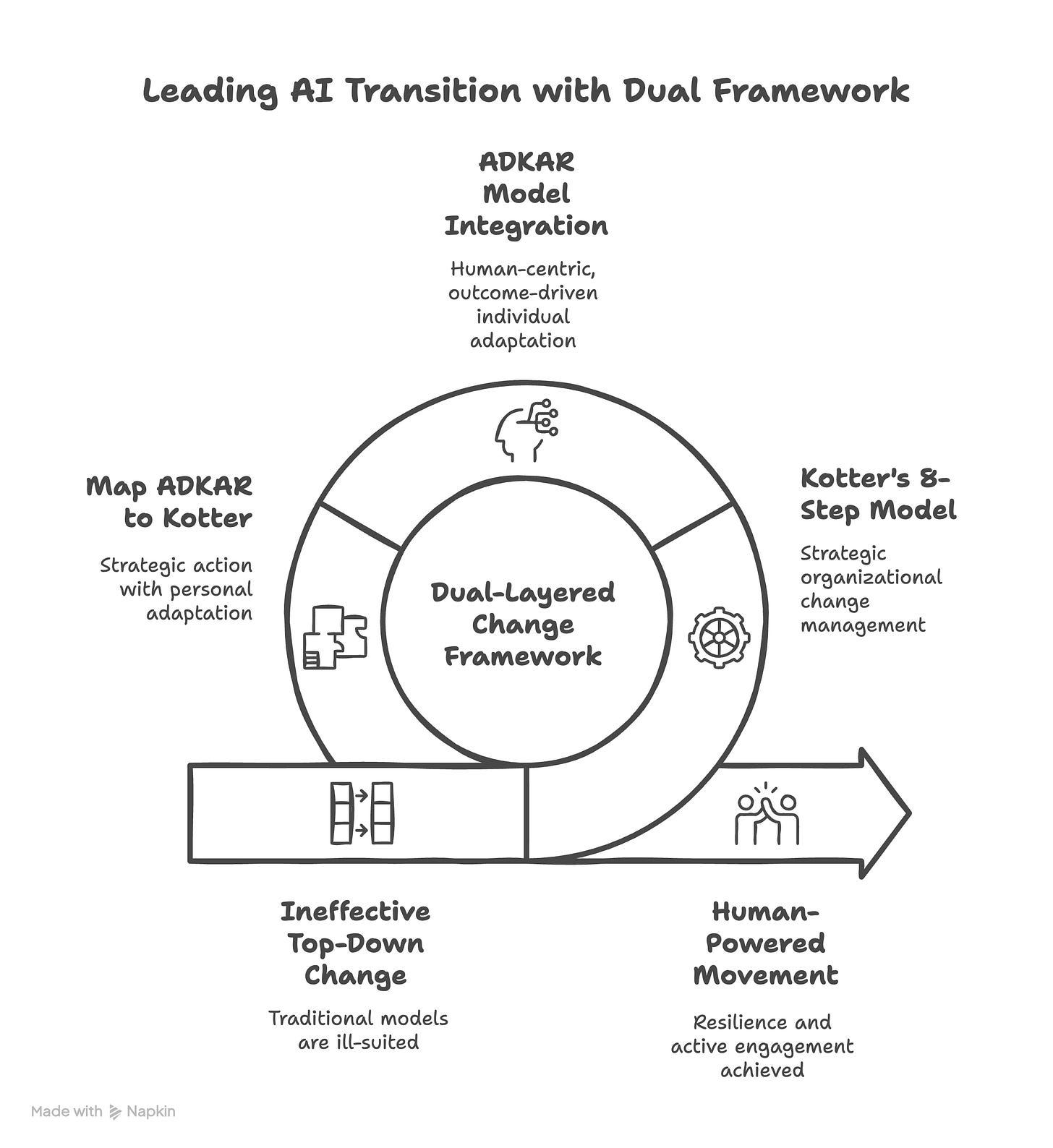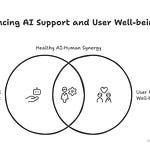Everyone’s still chasing the next shiny model, the next API, the next magical demo. But they’re missing the real story.
The biggest breakthroughs in AI aren’t happening in a lab; they’re happening in the messy, human world of change management.
The tech is basically a solved problem, a utility you can plug into. The real moat, the thing that will separate the winners from the losers, is cracking the code on your own team’s psychology. It’s a leadership challenge disguised as a technology problem.
In this edition, we’re not just looking at the tools; we’re giving you the playbook to navigate the human element, which is where the real war for competitive advantage will be won.
1. The leadership vacuum: a workforce divided by fear and productivity
I see this everywhere I look. The C-suite is talking about “leveraging synergistic platforms,” while half their team is secretly terrified they’ll be replaced by a chatbot and the other half is already using AI to finish their work by lunchtime on Wednesday. This isn’t a tech gap; it’s a trust and communication chasm. Leaders are so focused on the “what” (the tech) that they’ve completely forgotten the “who” (their people), and this disconnect is grinding innovation to a halt before it even starts.
The primary challenge in adopting generative AI is not the technology itself, but a profound leadership and communication gap. Organizations are grappling with a workforce deeply divided by an “AI Paradox”: a simultaneous and unprecedented level of fear and optimism. A significant portion of employees are anxious about their jobs being replaced or their professional value diminishing, with 45% fearing AI will make their jobs obsolete. This anxiety is so pronounced that for 51% of worried employees, it negatively impacts their mental health.
In stark contrast, an overwhelming majority of “augmented” employees are already using AI and reporting significant benefits, with 90% stating it saves them time and 84% feeling it makes them more creative. This chasm is widened by a leadership vacuum. While 79% of business leaders agree that AI adoption is critical for staying competitive, a staggering 60% worry that their own leadership lacks a clear vision or plan for its implementation.
This failure to provide a strategic narrative leaves teams fractured, hobbling innovation and risking the alienation of both anxious and enthusiastic employees.
2. The breakthrough: merging corporate change logic with individual psychology
So, how do you fix it? You stop thinking like a project manager rolling out new software and start thinking like a movement leader. You can’t just send a memo and schedule a training session for something this personal. The breakthrough isn’t a new piece of tech; it’s a framework that merges the cold, hard logistics of corporate change with the warm, messy reality of individual human psychology. It’s about ensuring that for every top-down strategic move, there’s a bottom-up answer to the question, “What does this mean for me?”
The most effective way to lead an organization through the AI transition is to adopt a dual-layered change management framework that addresses both the organization’s structure and the individual’s psychological journey simultaneously. This approach moves beyond traditional, top-down change models which are ill-suited for the personal and existential nature of AI’s impact.
The breakthrough is to synergize the structural, stage-based approach of John Kotter’s 8-Step change model with the human-centric, outcome-driven goals of Prosci’s ADKAR model (Awareness, Desire, Knowledge, Ability, Reinforcement). By mapping the individual ADKAR goals onto each of Kotter’s organizational steps, a leader can ensure that for every strategic action taken at the macro level, there is a corresponding focus on what each person needs to successfully adapt at the micro level. This transforms a corporate mandate into a human-powered movement, building resilience and turning resistance into active engagement.
3. Data-backed reality check: the flashing red lights on your AI dashboard
Don’t just take my word for it; the data is screaming the same story. These numbers aren’t just academic curiosities, they are flashing red lights on your strategic dashboard. The proof is right here: investing in AI without investing in the people who will use it is like buying a fleet of race cars and forgetting to hire any drivers. The data shows that the bottleneck isn’t the engine; it’s the person behind the wheel.
The biggest barrier to AI success is leadership, not technology. Research from McKinsey highlights that the primary obstacle is leaders failing to steer the change with sufficient speed and clarity. While 95% of companies have invested in AI, only 14% have successfully aligned their strategy and workforce to capitalize on it.
A one-size-fits-all change strategy is doomed to fail. The workforce is not a monolith; it’s a complex spectrum of emotion including curiosity (41%), caution (35%), and excitement (31%). A strategy must address the employee worried about replacement just as much as the one who is already saving hours each day with AI.
AI change is fundamentally different and more personal. Unlike past technology shifts like cloud computing, generative AI’s impact is existential, touching on job identity and personal value. Its speed is exponential and its nature is probabilistic, requiring new cognitive skills like prompt engineering and ethical reasoning, not just software training.
Individual readiness is the key to organizational change. The ADKAR model provides a clear roadmap for what an individual needs to change successfully: Awareness of the need for change, Desire to participate, Knowledge of how to change, Ability to implement new skills, and Reinforcement to make the change stick. Addressing these five outcomes is critical for adoption.
Psychological safety is the bedrock of AI innovation. To build the ability to experiment with AI, employees must feel safe to take interpersonal risks, such as questioning an AI’s output or admitting a mistake. This requires leaders to model vulnerability and frame work as a learning problem, not an execution problem.
4. From theory to execution: real-world examples of AI supercharging humans
And lest you think this is all just high-minded theory, let’s look at who’s already putting this into practice. These aren’t speculative pilots; these are real-world examples of companies getting a massive edge by treating AI as a creative partner, not just a cost-cutting tool. From cosmetics to cars to code, the pattern is the same: AI isn’t replacing the human, it’s supercharging them.
L’Oréal: AI-driven product ideation. To accelerate innovation, L’Oréal used generative AI to move beyond human intuition. The company’s system analyzed vast datasets of scientific research and consumer product reviews to brainstorm and generate novel ingredient combinations for its cosmetic products, uncovering new opportunities faster than traditional R&D.
Automotive OEM: radically accelerated prototyping. An automotive manufacturer leveraged generative AI to supercharge its design process. The AI generated 25 distinct and viable design concepts for a next-generation car dashboard in just two hours, a task that would typically take a human design team weeks or months.
GitHub Copilot: accelerating software development. Across the industry, firms are embedding AI directly into the software development lifecycle. By using AI code assistants like GitHub Copilot, some companies have cut the time spent developing new features by as much as 50%, as the AI generates boilerplate code, suggests completions, and helps developers learn new languages more efficiently.
5. Your strategic game plan: from team segmentation to C-suite buy-In
Okay, so enough diagnosis. Let’s talk about the cure. This isn’t a checklist to be delegated; it’s your personal game plan for next week. The single biggest mistake I see leaders make is waiting for a perfect, top-down, corporate-wide AI strategy. Forget that. You can start right now, with your own team, by making a few smart, targeted moves.
Diagnose and segment your team’s AI mindset. Abandon a one-size-fits-all leadership style. Just as you segment users, segment your team into personas to provide targeted support:
The AI-anxious: Focus on building psychological safety and creating a clear, structured upskilling plan that shows how their skills will evolve, not become obsolete.
The AI-skeptic: Persuade them with data. Target them with the tangible ROI and efficiency gains from small, successful pilot projects.
The AI-curious: Provide direction and safe "sandbox" environments where they can experiment with AI tools without fear of failure.
The AI-enthusiast: Empower this group immediately. Make them the core of your “guiding coalition” and enlist them as peer mentors to evangelize the benefits of AI.
Launch a human-centric change narrative. Frame AI adoption as a “launchpad” of opportunity, not a “burning platform” of fear. Create urgency by focusing on the competitive risks of inaction and the potential for market leadership. For every individual, you must clearly answer the question, “what's in it for me?” emphasizing how AI will automate tedious work and free them up for more creative, high-impact tasks.
Create psychological safety for experimentation. Make it safe to fail. Announce a “no-blame” policy for AI experiments and model vulnerability by admitting your own mistakes and uncertainties. Frame all AI-related projects as “learning problems, not execution problems” to encourage creative risk-taking.
Secure quick wins with pilot projects. Build momentum and overcome skepticism by launching small-scale pilot projects that target high-effort, low-value tasks. These projects are ripe for automation and provide the best chance for a clear, quantifiable ROI. Celebrate these wins publicly to build credibility and energize the organization.
Build and present a compelling business case to leadership. Fill the strategic vacuum by proactively building a business case for wider AI adoption. Structure it with a clear problem statement, a proposed solution with “quick win” use cases, a transparent cost and ROI breakdown, and a risk mitigation plan. Use a three-tiered approach to demonstrate ROI, quantifying not just cost savings but also operational KPIs (e.g., reduced cycle time) and adoption metrics (e.g., active user engagement).
Design and implement targeted upskilling programs. Convert anxiety into ability with a structured curriculum. Your training program must cover AI fundamentals, prompt engineering, AI ethics and responsible use, and hands-on training for specific company tools. Offer this training in multiple formats to cater to different learning styles.
So what’s the real story here? It’s that for all the talk about neural networks and processing power, the success of this revolution will be determined by our ability to manage human networks.
We’re facing an internal market of emotions (fear, skepticism, curiosity, and excitement) and leaders who ignore it in favor of a purely technical rollout are doomed. Connecting the dots is simple: the companies getting ahead are the ones who realized that getting people to want to use AI is infinitely more powerful than just giving them the tool. If you treat this as a communication challenge first and a technology challenge second, you’re already halfway to winning.
This leaves me with one big question for you to take back to your team: Are you spending as much time, energy, and capital on designing a human-centric adoption plan as you are on vetting your next AI vendor?














Share this post